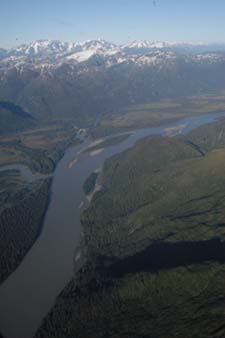Where Are the Birds?
Adapted From http://www.fs.fed.us/r10/ro/naturewatch/southeast/stikine_flats
Where is the Stikine River Delta?
The Stikine River Delta is located on the mainland of southeast Alaska, six miles west of Petersburg and seven miles north of Wrangell. The river is confined to a narrow valley by steep, rugged mountains. These surrounding mountains contain many active glaciers. Meltwater from th e glaciers has a high silt content, giving the Stikine a milky appearance. The delta at the mouth of the river is 17 miles wide, being formed from numerous slow moving "braided" channels (three of which are navigable). One hot and two warm springs are found adjacent to the river. Grass flats, tidal marshes, and shifting sandbars cover the delta area.
e glaciers has a high silt content, giving the Stikine a milky appearance. The delta at the mouth of the river is 17 miles wide, being formed from numerous slow moving "braided" channels (three of which are navigable). One hot and two warm springs are found adjacent to the river. Grass flats, tidal marshes, and shifting sandbars cover the delta area.
The Stikine River is the fastest navigable river in North America and stretches 400 miles from its headwaters in Canada. The river provides numerous and diverse recreational opportunities for the residents of Wrangell and visitors.
Alpine vegetation, including mosses, lichens, and other small plants, are found at elevations above 2,000 feet in the Stikine-LeConte Wilderness, which is about 448,841 acres. The lower mountain slopes near salt water support a dense spruce-hemlock rainforest. In the area's eastern portion approaching the Canadian border, the rainfall decreases and the vegetation changes to stands of cottonwood with dense underbrush. Cottonwood trees are also common on the many islands of the Stikine River.
Why is the Stikine River Delta so important to migrating birds?
The Stikine River Delta is a significant stopover on the Pacific Flyway. The migration begins with the arrival of spring in Alaska! In mid-April more than 14,000 snow geese, over 10,000 sandhill cranes, and almost 2,000 eagles begin the bird migration on the delta, converging on the area.
The concentration of eagles is the largest reported springtime concentration in North America. The eagles arrive to feast on the hooligan (smelt) migrating up the Stikine River to spawn. Eagles begin arriving in Wrangell in February. Mt. Dewey hillside is spotted with white heads and numerous eagles can be spotted sharing favorite trees in the middle of town.
The Stikine River Delta "flats” are a major resting and nesting area for migratory birds. Toward the end of April and early May, over 100,000 shorebirds begin arriving. Approximately 123 species are represented at any one time, including Short-eared owls, Northern Harriers and an occasional Goshawk, can be spotted during the height of the migration.
What other fish and wildlife use the Stikine River Delta besides migrating birds?
Much of the Wilderness, particularly the Stikine River drainage, is recognized as an important fish and wildlife area. Incredible opportunities to view bald eagles are available in the Stikine Flats Wildlife Viewing Area. Moose, mountain goats, brown and black bears, Stika black-tailed deer, and wolves inhabit the area. A variety of fish, including king and other species of salmon are found. In addition, the delta is swarming with seals and sea lions in the spring.
 Join In
Join In Archives
Archives